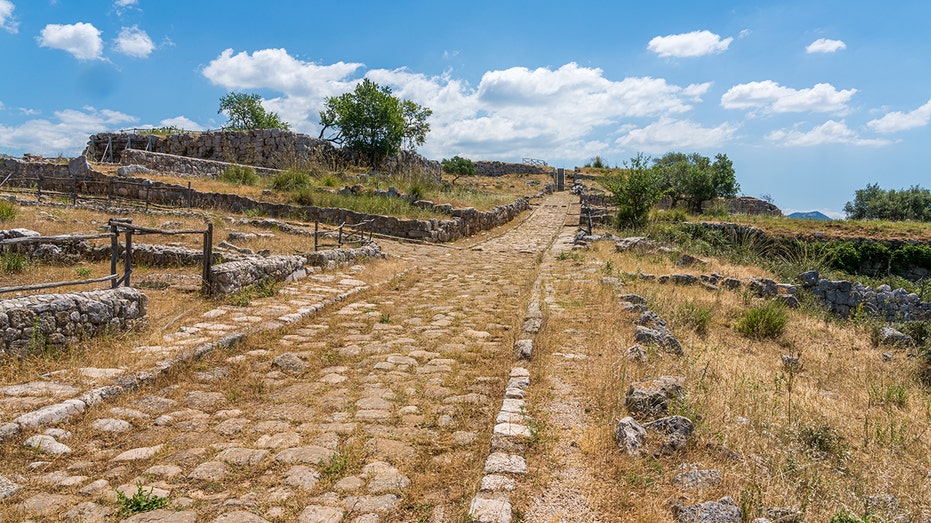Science
Archaeologists Expand Roman Road Network Discovery By 50%

A recent discovery in Gloucestershire, England, has led archaeologists to map a vast network of Roman roads, revealing that these ancient routes extend approximately 50% longer than previously recognized. This groundbreaking finding comes from a new digital atlas called Itiner-e, published this week, which documents nearly 300,000 kilometers (about 186,000 miles) of Roman roadways across Europe, North Africa, and the Middle East.
The research was initiated by an amateur metal detectorist’s discovery of Roman cavalry swords, prompting a closer examination of a 2,000-year-old settlement that included villa remains and other structures. According to sources from Cotswold Archaeology and Historic England, this study significantly expands the known Roman road network by over 100,000 kilometers.
Advanced Methodologies Transform Archaeological Research
The last comprehensive atlas of Roman roads was published 25 years ago, relying on incomplete records and analog mapping. In contrast, the Itiner-e project utilized modern digital methods, including satellite imagery and aerial photography, to uncover previously hidden routes. Researchers used historical documents, ancient journals, and locations of milestones over a span of five years to identify lost roads, analyzing terrain for subtle clues such as variations in vegetation and soil.
Tom Brughmans, an archaeologist and co-author of the study published in Scientific Data, described the process as “a massive game of connecting the dots on a continental scale.” The atlas now visualizes ancient pathways taken by Roman farmers, soldiers, and diplomats, potentially enhancing our understanding of historical trends influenced by the movement of people during Roman times.
The atlas illustrates routes that stretch from Spain to Syria, connecting over 5,000 ancient settlements. Previous estimates of the extant Roman road network were around 188,000 kilometers (approximately 117,000 miles), primarily focusing on major highways. The new findings reveal a complex web of secondary roads that linked villas, farms, and military outposts.
Implications for Future Research and Scholarship
The research provided critical insights into less-documented regions, particularly in North Africa, the interior plains of France, and the Peloponnese peninsula in Greece. Benjamin Ducke, affiliated with the German Archaeological Institute in Berlin, noted that this work will serve as foundational for further studies, although he cautioned that it remains unclear whether all the routes were active simultaneously.
The new atlas, named after the Ancient Roman itineraria that documented road stations and distances, combines historical records with modern GIS analysis and crowdsourced archaeological data. The Scientific Data release indicated that only 2% to 3% of the mapped routes have “high certainty,” meaning there are clear physical traces. The majority are inferred based on historical and environmental indicators.
Brughmans emphasized the significance of visualizing these ancient routes, which could reshape our understanding of key historical events, such as the rise of Christianity and the spread of ancient pandemics. Co-author Adam Pažout from the Autonomous University of Barcelona remarked on the profound impact of this road network on modern infrastructure, stating, “The Romans left a huge impact with this road network.”
The dataset and an interactive map are available for public access at itiner-e.org, allowing scholars and enthusiasts to explore ancient routes, milestones, and settlements in detail. As archaeological findings continue to unveil the complexities of Ancient Rome, they provide valuable insights not only for researchers but also for the general public interested in understanding our shared history.
-

 Top Stories2 weeks ago
Top Stories2 weeks agoMarc Buoniconti’s Legacy: 40 Years Later, Lives Transformed
-

 Health2 weeks ago
Health2 weeks agoInnovative Surgery Restores Confidence for Breast Cancer Patients
-

 Sports4 weeks ago
Sports4 weeks agoSteve Kerr Supports Jonathan Kuminga After Ejection in Preseason Game
-

 Science4 weeks ago
Science4 weeks agoChicago’s Viral ‘Rat Hole’ Likely Created by Squirrel, Study Reveals
-

 Entertainment4 weeks ago
Entertainment4 weeks agoZoe Saldana Advocates for James Cameron’s Avatar Documentary
-

 Politics4 weeks ago
Politics4 weeks agoDallin H. Oaks Assumes Leadership of Latter-day Saints Church
-

 Lifestyle4 weeks ago
Lifestyle4 weeks agoKelsea Ballerini Launches ‘Burn the Baggage’ Candle with Ranger Station
-

 Business4 weeks ago
Business4 weeks agoTyler Technologies Set to Reveal Q3 2025 Earnings on October 22
-

 Business3 weeks ago
Business3 weeks agoZacks Research Downgrades Equinox Gold to Strong Sell Rating
-

 Business3 weeks ago
Business3 weeks agoBusiness Schools Urged to Prioritize Economic Freedom Education
-

 Top Stories2 weeks ago
Top Stories2 weeks agoBOYNEXTDOOR’s Jaehyun Faces Backlash Amid BTS-TWICE Controversy
-

 Health3 weeks ago
Health3 weeks ago13-Year-Old Hospitalized After Swallowing 100 Magnets









